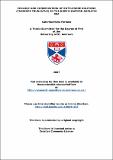Files in this item
Ecology and conservation of bottlenose dolphins (Tursiops truncatus) in the north-eastern Adriatic Sea
Item metadata
| dc.contributor.advisor | Hammond, Philip S. | |
| dc.contributor.author | Fortuna, Caterina Maria | |
| dc.coverage.spatial | xviii, 256 p. | en |
| dc.date.accessioned | 2007-01-31T11:31:27Z | |
| dc.date.available | 2007-01-31T11:31:27Z | |
| dc.date.issued | 2007 | |
| dc.identifier | uk.bl.ethos.551965 | |
| dc.identifier.uri | https://hdl.handle.net/10023/157 | |
| dc.description.abstract | Bottlenose dolphins of the Kvarnerić (NE Adriatic Sea) live in an area of increasing human impact, through tourism and small-scale fisheries. This thesis aimed to assess the status of the local population and to inform managers on factors affecting their distribution and abundance, using data from 1995-2003. Habitat modelling indicated a significant negative impact of proximity to the main ‘marine highway’ and to marine petrol stations. Evidence was found that dolphins may recently have reached a tolerance limit to the number of boats using the area and that they remember crowded areas from one year to the next. Dolphin presence was positively related to particular depths and trawling areas. Apparent adult survival rate was estimated to be significantly lower than for any other bottlenose dolphin population and first year calf survival was also low. A decreasing trend in fecundity rate was found. The population showed a considerable rate of non-random temporary emigration from the study area. The estimated size of the population was small and similar to two other European bottlenose dolphin populations (Moray Firth in Scotland and Shannon Estuary in Ireland). A significant decrease in abundance of about 39% from 1995 was estimated. PVA confirmed the importance of female adult survival to population viability and indicated that the current rate of human-induced mortality is unsustainable. Local extinction risk within three generations was estimated to be high (35%). Applying the IUCN Red List Criteria, the Kvarnerić population should be listed as Endangered under Criterion C and E. This study gives an important insight into the ecology of Adriatic bottlenose dolphins and indicates the need for a regionally and locally synergistic approach to conserve this population. | en |
| dc.format.extent | 2520320 bytes | |
| dc.format.mimetype | application/pdf | |
| dc.language.iso | en | en |
| dc.publisher | University of St Andrews | |
| dc.rights | Creative Commons Attribution-NonCommercial-NoDerivs 2.5 Generic | |
| dc.rights.uri | http://creativecommons.org/licenses/by-nc-nd/2.5/ | |
| dc.subject | Marine mammals | en |
| dc.subject | Cetaceans | en |
| dc.subject | Population dynamics | en |
| dc.subject | Conservation | en |
| dc.subject | Mediterranean Sea | en |
| dc.subject.lcc | QL737.C432F7 | |
| dc.subject.lcsh | Bottlenose dolphins--Adriatic Sea Region | en |
| dc.subject.lcsh | Bottlenose dolphins--Ecology--Adriatic Sea Region | en |
| dc.subject.lcsh | Bottlenose dolphins--Conservation--Adriatic Sea Region | en |
| dc.title | Ecology and conservation of bottlenose dolphins (Tursiops truncatus) in the north-eastern Adriatic Sea | en |
| dc.type | Thesis | en |
| dc.type.qualificationlevel | Doctoral | en |
| dc.type.qualificationname | PhD Doctor of Philosophy | en |
| dc.publisher.institution | The University of St Andrews | en |
| dc.publisher.department | Sea Mammal Research Unit | en |
This item appears in the following Collection(s)
Except where otherwise noted within the work, this item's licence for re-use is described as Creative Commons Attribution-NonCommercial-NoDerivs 2.5 Generic
Items in the St Andrews Research Repository are protected by copyright, with all rights reserved, unless otherwise indicated.


